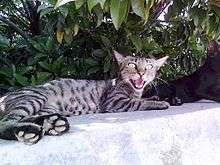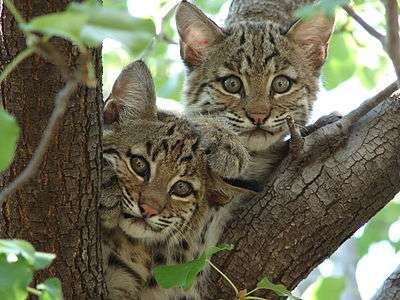Kitten

A kitten (also known as a kitty or kitty cat) is a juvenile cat. After being born, kittens are totally dependent on their mother for survival and they do not normally open their eyes until after seven to ten days. After about two weeks, kittens quickly develop and begin to explore the world outside the nest. After a further three to four weeks, they begin to eat solid food and grow adult teeth. Domestic kittens are highly social animals and enjoy human companionship.
Etymology and development
The word "kitten" derives from the Middle English word kitoun, which in turn came from the Old French chitoun or cheton.[1] The big cats are called "cubs" rather than kittens; either term may be used for the young of smaller wild felids, such as ocelots, caracals and lynx, but "kitten" is usually more common for these species.[2]


A feline litter usually consists of two to five kittens.[3] The kits are born after a gestation that lasts between 64 and 67 days, with an average length of 66 days.[3] Kittens emerge in a sac called the amnion, which is bitten off and eaten by the mother cat.[4]
For the first several weeks, kittens are unable to urinate or defecate without being stimulated by their mother.[5] They are also unable to regulate their body temperature for the first three weeks, so kittens born in temperatures less than 27 °C (81 °F) can die from hypothermia if their mother does not keep them warm.[6] The mother's milk is very important for the kittens' nutrition and proper growth. This milk transfers antibodies to the kittens, which helps protect them against infectious disease.[7] Newborn kittens are unable to produce concentrated urine, and so have a very high requirement for fluids.[8] Kittens open their eyes about seven to ten days after birth. At first, the retina is poorly developed and vision is poor. Kittens are not able to see as well as adult cats until about ten weeks after birth.[9]
Kittens develop very quickly from about two weeks of age until their seventh week. Their coordination and strength improve. They play-fight with their litter-mates and begin to explore the world outside the nest or den. They learn to wash themselves and others as well as play hunting and stalking games, showing their inborn ability as predators. These innate skills are developed by the kittens' mother or other adult cats, who bring live prey to the nest. Later, the adult cats demonstrate hunting techniques for the kittens to emulate.[10] As they reach three to four weeks old, the kittens are gradually weaned and begin to eat solid food, with weaning usually complete by six to eight weeks.[11] Kittens generally begin to lose their baby teeth around three months of age, and have a complete set of adult teeth by nine months.[12] Kittens live primarily on solid food after weaning, but usually continue to suckle from time to time until separated from their mothers. Some mother cats will scatter their kittens as early as three months of age, while others continue to look after them until they approach sexual maturity.[13]
The sex of kittens is usually easy to determine at birth. By six to eight weeks they are harder to sex because of the growth of fur in the genital region. The male's urethral opening is round, whereas the female's urethral opening is a slit. Another marked difference is the distance between anus and urethral opening, which is greater in males than in females.[14]
Kittens are highly social animals and spend most of their waking hours interacting with available animals and playing on their own. Play with other kittens peaks in the third or fourth month after birth, with more solitary hunting and stalking play peaking later, at about five months.[15]
Kittens are vulnerable because they like to find dark places to hide, sometimes with fatal results if they are not watched carefully.[16]
Although domestic kittens are commonly sent to new homes at six to eight weeks of age, it has been suggested that being with its mother and litter mates from six to twelve weeks is important for a kitten's social and behavioural development.[15] Usually, breeders and foster/rescue homes will not sell or adopt out a kitten that is younger than twelve weeks, and in many jurisdictions, it is illegal to give away kittens younger than eight weeks old.[17] Kittens generally reach sexual maturity around seven months of age. A cat reaches full "adulthood" around one year of age.[18]
Health
Domestic kittens in developed societies are usually vaccinated against common illnesses from two to three months of age. The usual combination vaccination protects against feline viral rhinotracheitis (FVR), feline calicivirus (C), and feline panleukopenia (P). This FVRCP inoculation is usually given at eight, twelve, and sixteen weeks, and an inoculation against rabies may be given at sixteen weeks. Kittens are usually spayed or neutered at seven months of age, but kittens may be neutered as young as seven weeks (if large enough), especially in animal shelters.[19] Such early neutering does not appear to have any long-term health risks to cats, and may even be beneficial in male cats.[20] Kittens are commonly wormed against roundworms from about four weeks.[21]
Orphaned kittens
Kittens require a high-calorie diet that contains more protein than the diet of adult cats.[22] Young orphaned kittens require cat milk every two to four hours, and they need physical stimulation to defecate and urinate.[5] Cat milk replacement is manufactured to feed to young kittens, because cow's milk does not provide all the necessary nutrients.[23] Human-reared kittens tend to be very affectionate with humans as adults and sometimes more dependent on them than kittens reared by their mothers, but they can also show volatile mood swings and aggression.[24] Depending on the age at which they were orphaned and how long they were without their mothers, these kittens may be severely underweight and can have health problems later in life, such as heart conditions. The compromised immune system of orphaned kittens (from lack of antibodies found naturally in the mother's milk) can make them especially susceptible to infections, making antibiotics a necessity.[25]
Gallery
 A ginger and white Maine Coon kitten, aged ten weeks
A ginger and white Maine Coon kitten, aged ten weeks A kitten and a mirror
A kitten and a mirror
 Bobcat kittens, about two to four months old
Bobcat kittens, about two to four months old_Hugo_by_TAnthony.jpg) Highlander kitten, with distinctive curled ears and bobtail
Highlander kitten, with distinctive curled ears and bobtail
See also
References
- ↑ Oxford Dictionary 2005.
- ↑ Sunquist & Sunquist 2014, pp. 58–59.
- 1 2 Tsutsui & Stabenfeldt 1993, p. 1699.
- ↑ Vandivert 1975, p. 53.
- 1 2 Pet Education 2011.
- ↑ International Cat Care 2015.
- ↑ Casal, Jezyk & Giger 1996, p. 1653.
- ↑ Sturgess & Hurley 2005, p. 243.
- ↑ Tootle & Friedlander 1989, p. 1325.
- ↑ Poirier & Hussey 1982, pp. 133–148.
- ↑ Sturgess & Hurley 2005, p. 244.
- ↑ Veterinary Medicine 2013.
- ↑ Bönisch 1996, pp. 23–24.
- ↑ Walls 1991, p. 22.
- 1 2 Crowell-Davis 2005, p. 18.
- ↑ Cats have a habit of seeking refuge under or inside cars or on top of car tires during stormy or cold weather. This often leads to broken bones, burns, heat stroke, damaged internal organs or death. Daphne Sashin, Five Risky Hiding Places For Cats. WebMD, September 14, 2010.
- ↑ Sunquist & Sunquist 2014, p. 111.
- ↑ Santa Maria Times 2013.
- ↑ Olson, Kustritz & Johnston 2001, pp. 223–232.
- ↑ Spain, Scarlett & Houpt 2004, pp. 372–379.
- ↑ McHattie 1993, p. 121.
- ↑ Rogers & Morris 1979, pp. 718–723.
- ↑ Guilford 1994, pp. 2663–2669.
- ↑ Heath 2005, p. 102.
- ↑ Messonnier 2010, p. 375.
Sources
Printed
- Bönisch, Susanne (1996). Natural Healing for Cats. Sterling Publishing Company. ISBN 978-0-8069-8122-2.
- Casal, Margret; Jezyk, Peter; Giger, Urs (1996). Transfer of Colostral Antibodies From Queens to Their Kittens. American Journal of Veterinary Research. PMID 8915447.
- Crowell-Davis, Sharon (2005). Cat Behaviour: Social Organization, Communication and Development. Rochlitz. doi:10.1007/1-4020-3227-7_1.
- Guilford, Grant (1994). Nutritional Management of Gastrointestinal Tract Diseases of Dogs and Cats. Journal of Nutrition. PMID 7996263.
- Heath, Sarah (2005). Behaviour Problems and Welfare. Rochlitz. doi:10.1007/1-4020-3227-7_4.
- McHattie, Grace (1993). That's Cats! A Compendium of Feline Facts. David & Charles. ISBN 978-0-7153-0126-5.
- Messonnier, Shawn (2010). Natural Health Bible for Dogs & Cats: Your A-Z Guide to Over 200 Conditions, Herbs, Vitamins, and Supplements. Crown/Archetype Publishing. ISBN 978-0-307-55860-2.
- Olson, Patricia; Kustritz, Margaret; Johnston, Shirley (2001). Early-age Neutering of Dogs and Cats in the United States. Journal of Reproduction and Fertility Supplement. PMID 11787153.
- Poirier, Frank; Hussey, Kaye (1982). Nonhuman Primate Learning: The Importance of Learning from an Evolutionary Perspective. Anthropology & Education Quarterly. JSTOR 3216627.
- Rogers, Quinton; Morris, James (1979). Essentiality of Amino Acids for the Growing Kitten. Journal of Nutrition. PMID 430271.
- Spain, Victor; Scarlett, Janet; Houpt, Katherine (2004). Long-term Risks and Benefits of Early-age Gonadectomy in Cats. Journal of the American Veterinary Medical Association. doi:10.2460/javma.2004.224.372.
- Sturgess, Kit; Hurley, Karyl (2005). Nutrition and Welfare. Rochlitz. doi:10.1007/1-4020-3227-7_9.
- Sunquist, Fiona; Sunquist, Mel (2014). The Wild Cat Book: Everything You Ever Wanted to Know About Cats. Chicago University. ISBN 978-0-226-14576-1.
- Tootle, John; Friedlander, Michael (1989). Postnatal Development of the Spatial Contrast Sensitivity of X- and Y-cells in the Kittens Retinogeniculate Pathway. Journal of Neuroscience. PMID 2703879.
- Tsutsui, Toshihiko; Stabenfeldt, George (1993). Biology of Ovarian Cycles, Pregnancy and Pseudo Pregnancy in the Domestic Cat. Journal of Reproduction and Fertility Supplement. PMID 8229938.
- Vandivert, Rita (1975). Understanding Animals as Pets. Illustrated Publishing. ISBN 978-0-7232-6118-6.
- Walls, Jerry (1991). Kittens as a New Pet. TFH Publications. ISBN 978-0-86622-614-1.
Online
- "How to Raise Orphaned Kittens". Pet Education. Retrieved 7 March 2011.
- "Kittens Deaths ('Fading Kittens')". International Cat Care. Retrieved 28 March 2015.
- "Kitten". Oxford Dictionary. Retrieved 15 September 2005.
- "When Does a Kitten Become a Cat?". Santa Maria Times. Retrieved 12 October 2013.
- "When Do Puppies and Kittens Lose Their Baby Teeth?". Veterinary Medicine. Retrieved 1 November 2013.
External links
-
 Media related to Kitten at Wikimedia Commons
Media related to Kitten at Wikimedia Commons -
 How to choose your pet and take care of it at Wikibooks
How to choose your pet and take care of it at Wikibooks -
 The dictionary definition of kitten at Wiktionary
The dictionary definition of kitten at Wiktionary